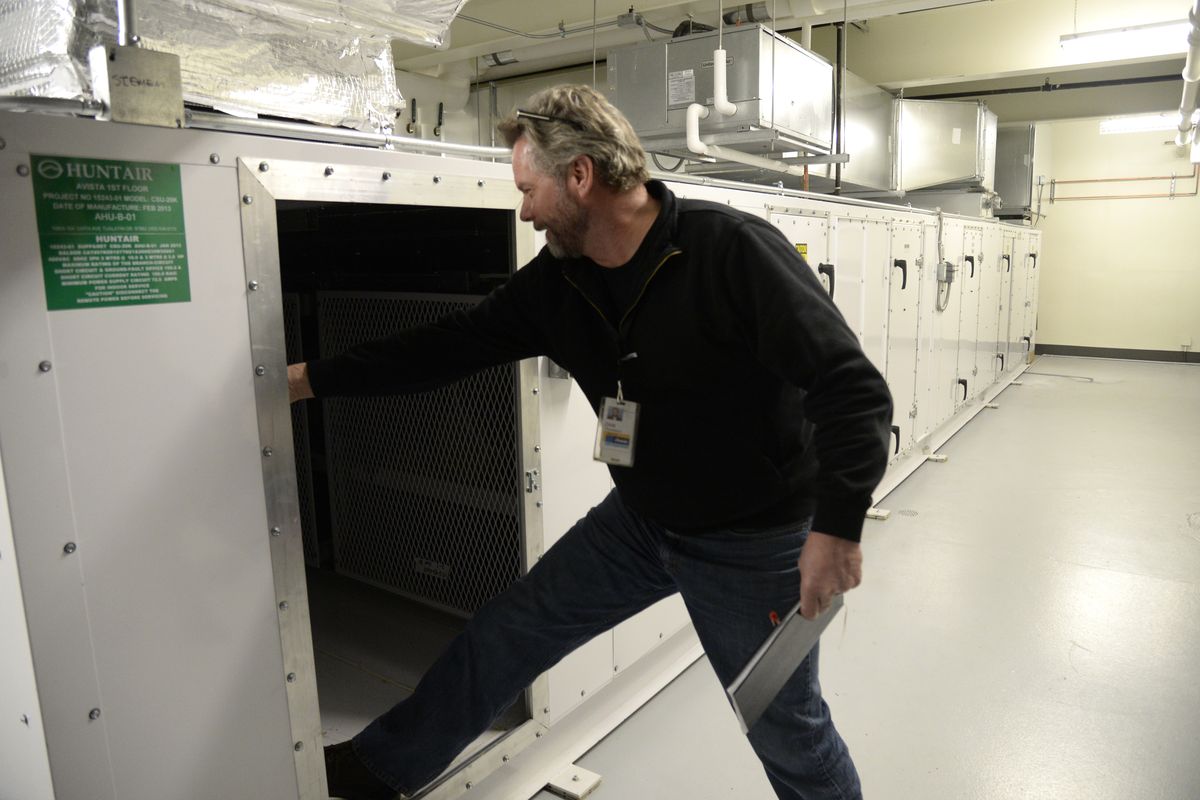Avista’s aging headquarters gets energy-efficiency update

Even Avista watches its power bills.
When the heating-and-cooling system at the Spokane utility’s corporate headquarters passed the half-century mark a few years ago, officials decided it was time for a replacement.
The new system is part of a $28 million energy-efficiency remodel that will eventually cut power costs at the utility’s headquarters on Mission Avenue by $275,000 per year. The updates will save about 2.8 million kilowatt hours of electricity annually, or enough to power 233 homes.
“We’re asking our customers to use energy wisely,” said Laurine Jue, a company spokeswoman. “This project allows Avista to be a better steward, too.”
Avista’s five-story headquarters won a national architecture award after it opened in 1959. The long rectangular building, with its iconic blue panels, is a tribute to mid-century architecture, said Eric Bowles, the utility’s facilities manager. The building’s energy efficiency was leading edge for that era, too.
“It had the third-largest heat pump system in the world,” Bowles said.
But after running continuously for 50 years, the system was showing its age.
The utility hired McKinstry to oversee a retrofitting of the original headquarters building and a 1970s addition. The project encompasses 150,000 square feet of office space, and includes new windows, insulation, lighting and asbestos abatement.
The construction has taken place on a floor-by-floor basis to reduce disruptions to the 650 workers housed in the two buildings. Each floor is a nine-month project. The five-year retrofit is scheduled to wrap up next August.
“It’s similar to buying a 1950s home and upgrading it for energy efficiency,” but with the work occurring on a much larger scale, said Dan Thompson, McKinstry’s construction superintendent.
More than 600 windows have been replaced with insulated panes that will reduce heat loss during cold months and reflect solar energy during the summer.
Better use of natural light is also part of the retrofit. Offices built along the windows were blocking the light and keeping it from reaching employees in cubicles.
McKinstry moved the offices so they’re banked along the building’s interior walls. Cubicle partitions are now perpendicular to the windows, so natural light penetrates the entire work area. Daylight sensors automatically adjust mechanical lighting in work stations.
“Lighting used to be a big source of complaints,” Bowles said.
The old fluorescent bulbs emitted harsh, yellow-brown light, which led to complaints about glare, he said. Using natural light, combined with lower-watt bulbs, has reduced both energy use and the number of complaints about eye strain and headaches.
But the retrofit’s big ticket savings come from the new cooling system.
In the last few decades, the use of computers has dramatically changed office buildings’ needs for air conditioning, Bowles said. The heat generated by computers, lights and Avista’s workforce makes air conditioning the biggest demand year ’round.
During the summer months, a heat-exchange system uses 55-degree well water to keep Avista’s headquarters comfortable for workers. When temperatures are moderate, the heat-exchange system relies on outside air for cooling. And on the limited number of winter mornings when heat is needed, a high-efficiency boiler fires up.
So far, the retrofit has saved Avista more than $1 million in energy costs, and parts of the remodel have qualified for the U.S. Green Building Council’s LEED Gold Certification.
Avista’s customers are paying for the cost of the renovations through their rates, said Jue, the utility spokeswoman. But the long-term savings from reduced energy use will also be reflected in future rates, she said.
“These investments will serve us for at least another 50 years,” Bowles said.